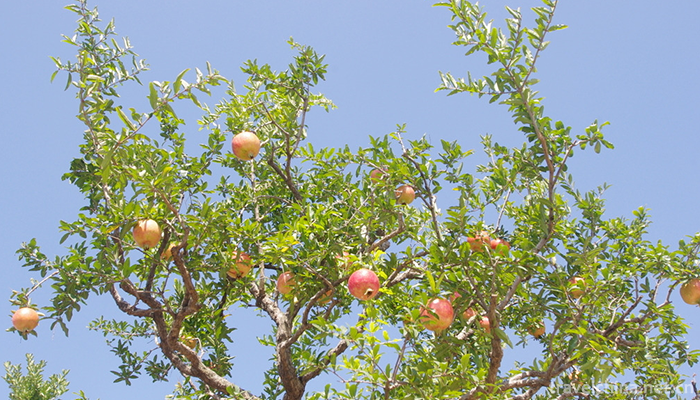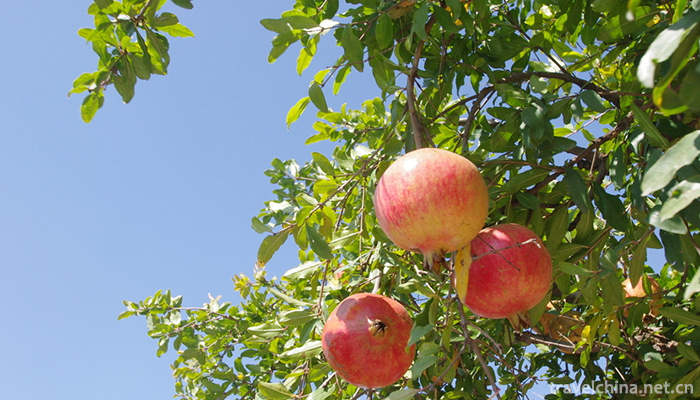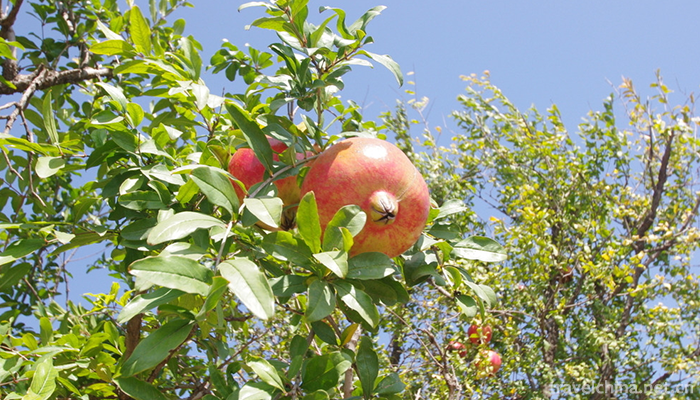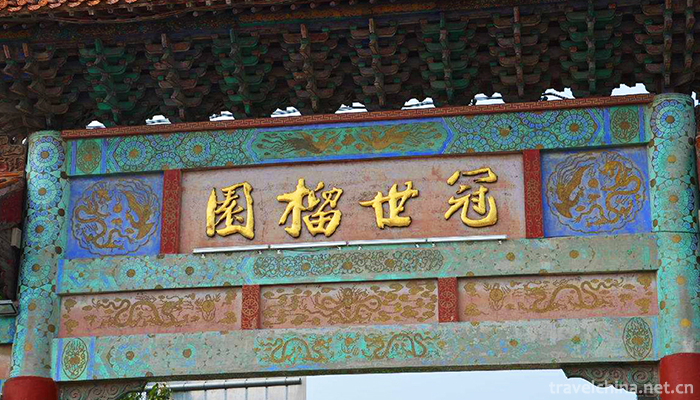Guanshi Pomegranate Garden Eco-cultural Tourist Area is located in the south of Zaozhuang City, Shandong Province, and in the west of Fucheng District. It is 22.5 kilometers long in East and 22.5 kilometers long in west, 3 kilometers wide in North and south, and has an area of 80 square kilometers. There are more than 530,000 pomegranate trees and 48 varieties in the park.
Guanshi Pomegranate Garden Eco-cultural Tourist Area was built in the reign of Chengdi in the Western Han Dynasty. It has a history of 2000 years. It has been certified as "the best of Guinness" by the Guinness Headquarters of Shanghai Great World, thus it is known as "Guanshi Pomegranate Garden".
On May 25, 2015, Guanshi Pomegranate Garden Eco-cultural Tourist Area was awarded the National AAAA Tourist Scenic Area.
Development history
Guanshi Pomegranate Garden was built in the reign of Chengdi in the Western Han Dynasty. It has a history of 2000 years.
Guanshi pomegranate garden eco-cultural tourist area used to be Qinghongshan, also known as Yunfeng Mountain, known as "Qinghong autumn color" is known as one of the eight sceneries in Gufu County.
In 1985, Guanshi Pomegranate Garden Eco-cultural Tourist Area began to prepare for the construction of pomegranate garden. It integrates the development of pomegranate garden resources, the construction of tourist area and the greening and beautification. It has been striving for three years and invested 1.3 million yuan, making the pomegranate garden in Fuxian County appear on Zaozhuang earth veritably.
In 2013, the South Gate of Pomegranate in Guanshi Pomegranate Garden was completed.
In 2013, the promotion and establishment of Guanshi Pomegranate Garden 5A is steadily advancing, with a total investment of 200 million yuan and a planned completion rate of 20,350 square meters of total construction area reaching 60%; the investment attraction and investment attraction of seven major nodes around the planned design of Beilongtang Silver Hair Health Care Zone and Pomegranate Culture Theme Park have begun; the main body of the project of the Pomegranate Culture Expo Park has been completed, and the interior decoration and exhibition design is being carried out; Yaoyu Eco-tourism Project has signed a development contract, the construction of mountain roads and land leveling in 2013.
From January to August 2013, the Guanshi Pomegranate Garden scenic spot received 700,000 tourists successively, and realized a comprehensive tourism income of 47.5 million yuan.
In 2014, the development and construction of Guanshi Pomegranate Garden entrance square, Fuyun Corridor image gate, landscape avenue, large-scale ecological parking lot, tourist service center, transfer parking lot, leisure shopping street, waterfront landscape belt were basically completed.
At the end of 2014, Guanshi Pomegranate Garden will construct two restaurant service facilities, including Liuyuan Villa, Dunhua Villa, Summer Palace, Shengquan Villa and large-scale farmhouse entertainment, 14 ecological cabins, ecological restaurants and service industry complex, and improve the functions of leisure and vacation, catering and entertainment, learning and training in scenic spots.
geographical environment
Location context
Guanshi Pomegranate Garden Eco-cultural Tourist Area is located in the north latitude of 34 degrees 46'54.42 and east longitude of 117 degrees 33'14.28. In the southern part of Zaozhuang City and the western part of Fucheng District, Shandong Province, the mountains are 22.5 kilometers long in East and west, 3 kilometers wide in North and south, with an area of 80 square kilometers.
climate
The climate of Guanshi pomegranate garden eco-cultural tourist area belongs to warm temperate monsoon climate area. The four seasons are distinct, the monsoon is obvious, and the rain and heat are in the same season. Due to the influence of the climate of the Yellow Sea, there are many easterly winds, but the marine climate of the mainland is not typical enough. The average annual sunshine time in scenic spots is 2226.4 hours, with the most sunshine hours in April and May, reaching 216.5 hours per month. The scenic spot has the longest winter, followed by summer, and slightly longer spring than autumn. It has the characteristics of long duration of cold and heat. The annual average temperature is 14.5 C, and the precipitation in the whole region is abundant, with an annual average precipitation of 872.9 mm. Among them, 64% are in summer, 16.7% in autumn, 4.1% in winter and 14.5% in spring.
topographic features
The topography of Guanshi pomegranate garden eco-cultural tourism area inclines northwest to southeast, followed by low hills, Piedmont plains and depressions. The highest altitude is 350.8 meters and the lowest is 29.5 meters.
natural resources
edit
In 1995, there were more than 20 species of wildlife in Guanshi Pomegranate Garden, including weasel, fox, wolf, rabbit, hedgehog and so on; 8 species of wild plants were Artemisia annua, Huangcao, Maotao, climbing tiger and castor; Chinese yam, ginseng, jujube, Xanthium sibiricum, Pinellia ternata, wild chrysanthemum, bathroom, honeysuckle, Valley essence grass, Zelacquer, Shushou Wu and other species of wild animals; jube tree, pomegranate, poplar, castor, etc. There are 9 kinds of trees, such as pine, peach and plum. Among them, there are more than 530,000 pomegranate trees and 48 varieties of pomegranate.
Scenic spot distribution
Guanshi Pomegranate Garden Eco-cultural Tourist Area is situated on the Xiangyang Hillside, which stretches more than 20 miles west of Fucheng City. It is 45 miles east-west, 6 miles wide north-south and covers 120,000 mu. The scenic area is open and flat, and can satisfy tens of thousands of tent for vacation and leisure at the same time. Within 5 kilometers, the area is flat, with numerous mountain springs, such as cold springs, Niubezi springs, and so on. It is close to the pomegranate plantation and the Three Near Academy. There are many scenic spots such as Yuanzhong Garden.
Tourism information
Traffic guide
Beijing-Fuzhou Expressway goes north (or south) to Zaozhuang Exit, then goes to Zaozhuang Bus Station, and then goes south-west along National Highway 206 to Guanshi Pomegranate Garden Entrance.
Shunjing-Shanghai Expressway goes north (or south) to Tangzhuang exit of Linyi, then goes to Zaozhuang bus station, and then goes south to Fucheng bus station along National Highway 206, and then to Guanshi pomegranate garden.
Nearby bus station: Fucheng is close to Zaozhuang city, Beijing-Shanghai Railway and Beijing-Fuzhou Expressway pass through Xierguo, 206 National Highway and provincial Tanxue Highway are nearby, 60 kilometers away from Xuzhou Guanyin International Airport, and only 18 kilometers away from Beijing-Hangzhou Canal. Major cities all over the country visit Guanshi Pomegranate Garden. Railway can get off at Zaozhuang West Station, transfer to Zaozhuang bus, and then take the bus line to Guanshi Pomegranate Garden or take No. 1 bus.
Starting from the Triangle Garden, the Bus Tourist Line passes through Jiefang Road, 206 National Highway and Guanshi Pomegranate Garden Scenic Spot, covering a total distance of 15 kilometers. Six luxury medium-sized buses are put into operation in advance, every 15 minutes.
Opening Hours
Business hours: 7:30-18:30 Qingtan Temple opens from 7:30 to 18:30 every day.
The garden is open from 8:00 to 18:00 every day.
Yiwangting Pavilion opens from 8:00 to 18:00 every day
Total Price of Guanshi Pomegranate Garden Eco-cultural Tourist Area: 124 yuan
The total ticket price of Guanshi Pomegranate Garden is 32 yuan.
The ticket price of Qingdan Temple is 80 yuan per person.
The price of garden ticket is 5 yuan.
The ticket price of one-view Pavilion is 5 yuan per person.
Kuangheng Tomb ticket price is 2 yuan per person.




0 Questions
Ask a Question
Your email address will not be published.